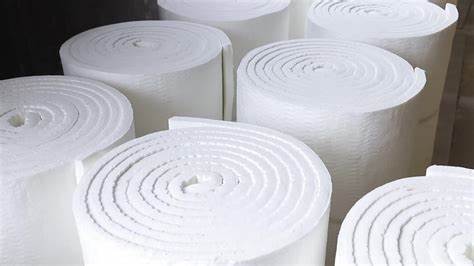Ceramic fiber blanket is a light weight refractory material which has excellent thermal insulation property, low thermal conductivity, good flexibility, fine corrosion resistance and sound insulation properties. Ceramic fiber blanket does not contain any binders.
The main components of ceramic fibers are alumina and silicon oxide, with a small number of other components. The raw materials are mixed and then heated in the electrical resistance furnace. After heating, they become a molten liquid and then convert the liquid into spun ceramic fiber through centrifugal force.
The cotton like spun ceramic fiber is evenly distributed on the belt of the collector, and then it is fed in to the needling machine. After double sided needled, it turns the ceramic fiber cotton into the needled ceramic fiber blanket. Through interweaving process, there are no layers between fibers and the blanket becomes tight and strong. The blanket passes through the conveyor belt and the grease is volatilized by the heat treatment furnace. The needled ceramic fiber blanket is shaped and the fiber is crystallized to improve its use temperature. After cross-cutting and winding, the finished product is completed.
Now nearly all the ceramic fiber blankets are spun blankets. The ceramic fibre spun blankets are stronger than the ceramic fiber blown blankets, because their fibers are thicker and longer than the blown blankets. Ceramic fiber blanket is widely used in the thermal insulation fields. It can be used as thermal insulation lining material for high temperature furnaces and other heating equipments. The blanket is very soft and also can be used as wrapping and covering materials for many equipments.
